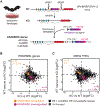Recurrent evolution of vertebrate transcription factors by transposase capture
- PMID: 33602827
- PMCID: PMC8186458
- DOI: 10.1126/science.abc6405
Recurrent evolution of vertebrate transcription factors by transposase capture
Abstract
Genes with novel cellular functions may evolve through exon shuffling, which can assemble novel protein architectures. Here, we show that DNA transposons provide a recurrent supply of materials to assemble protein-coding genes through exon shuffling. We find that transposase domains have been captured-primarily via alternative splicing-to form fusion proteins at least 94 times independently over the course of ~350 million years of tetrapod evolution. We find an excess of transposase DNA binding domains fused to host regulatory domains, especially the Krüppel-associated box (KRAB) domain, and identify four independently evolved KRAB-transposase fusion proteins repressing gene expression in a sequence-specific fashion. The bat-specific KRABINER fusion protein binds its cognate transposons genome-wide and controls a network of genes and cis-regulatory elements. These results illustrate how a transcription factor and its binding sites can emerge.
Copyright © 2020 The Authors, some rights reserved; exclusive licensee American Association for the Advancement of Science. No claim to original U.S. Government Works.
Conflict of interest statement
Figures






Comment in
-
New genes from borrowed parts.Science. 2021 Feb 19;371(6531):779-780. doi: 10.1126/science.abf8493. Science. 2021. PMID: 33602841 No abstract available.
-
Capturing transposases for new proteins.Nat Rev Genet. 2021 May;22(5):266-267. doi: 10.1038/s41576-021-00347-7. Nat Rev Genet. 2021. PMID: 33658661 No abstract available.
References
-
- Ohno S, Evolution by Gene Duplication. (Springer-Verlag, Berlin, Heidelberg, 1970).
-
- Ruddle FH et al., Evolution of Hox Genes. Annual review of genetics 28, 423–442 (1994). - PubMed
-
- Bouchard M, Schleiffer A, Eisenhaber F, Busslinger M, PaxGenes: Evolution and Function. (John Wiley & Sons, Ltd, Chichester, UK, 2008), vol. 20, pp. 5736.
Publication types
MeSH terms
Substances
Grants and funding
LinkOut - more resources
Full Text Sources
Other Literature Sources

